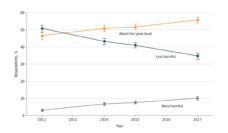Despite declines in cigarette smoking, use of non-cigarette tobacco products remains high or is increasing among adolescents and young adults. This includes use of cigarillos (small cigars), hookah, and vaping Juul or other e-cigarettes.
To counter these trends, we need to educate adolescents and young adults about the risks of these tobacco products. Youth use is partially due to misperceptions that these products are safer than cigarettes. Yet, in the case of cigarillos and hookah, the risks are similar to combustible cigarettes.
Talking with youth, we identified some do’s and don’ts for the design and delivery of appealing and engaging tobacco education.
To appeal to and engage youth, tobacco prevention and control messages must be strategic. What we show and how we show it will determine whether or not teens pay attention.
1. Novel facts are important.
Short, concise facts that aren’t your run of the mill “smoking is bad” are key. Hearing something new is desired.
Strategies that resonate include sharing specifics for how these products or chemicals in them harm the body, listing chemicals, linking these chemicals to other gross products, debunking misperceptions, blaming Big Tobacco, or highlighting negative financial or social implications of use. All are of great interest to youth. But make it brief to stick. Youth want to skim. Use brevity to your advantage and share multiple new ideas.
2. Facts must have sources.
This skeptical generation wants the facts, and, more importantly, where this information came from. They want it at-a-glance and they want to be able to dig deep with the original source.
3. Tone matters.
Youth won’t tolerate messages that are authoritative, condescending, or instructional in tone. They want the information. They want it simply put. They will make their own conclusions.
Sarcasm, if done well, is appreciated.
Lastly, make sure not to blame users. Blame the industry; sure, that’s fine, but not youth. They want information, not a lecture.
4. There is a desire to engage.
If given the option, youth often prefer to engage with content. Simple quizzes–true/false or multiple choice–allow users to test their knowledge. Quizzes can guide youth through facts while keeping them interested. Games are good, too, but are limited by a higher price tag and steep learning curves.
5. Don’t send mixed messages (with visuals).
Alluring images, are just that–alluring! Don’t use images that make using tobacco products appealing. For instance, comparing flavors to candy by showing yummy sweets is a bad idea.
Instead, use images that share the same message and meaning. For example, youth liked pairing novel information about arsenic (dangerous!) with a gross, yet a little cool, image of a cockroach. Throw in some sarcastic copy like, “Talk about a killer buzz,” (see #3) and now you have something that gets their attention.
6. Colors should guide.
Youth desire appealing colors–bold, not too bright, and not too many. Select a limited color palette and use intentionally. For example, color changes across topics/sections are an easy way for users to tell when there is new information at-a-glance.
7. Designs should be responsive.
Youth desire consistency. They want information that looks and functions the same regardless of their device. Teens toggle between devices and don’t want a different user experience with each switch.
Considering that youth reach for mobile devices first, leverage a few single scroll pages to minimize menu use and maximize accessibility from both touch screens and monitors.
In sum, developing online tobacco education should be done with the user in mind. To appeal to and engage youth, tobacco prevention and control messages must be strategic. What we show and how we show it will determine whether or not teens pay attention.
Photo courtesy of Lisa Bransom














